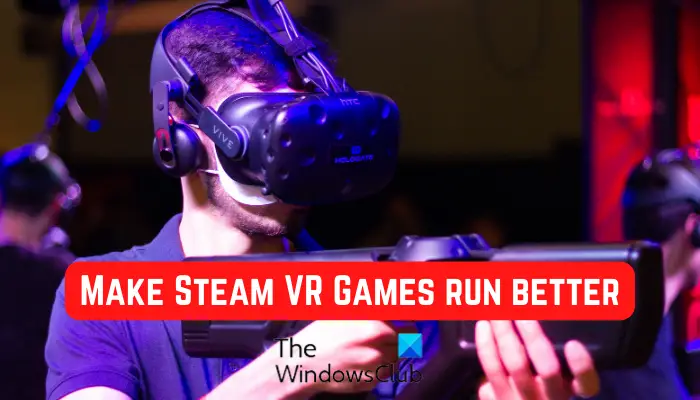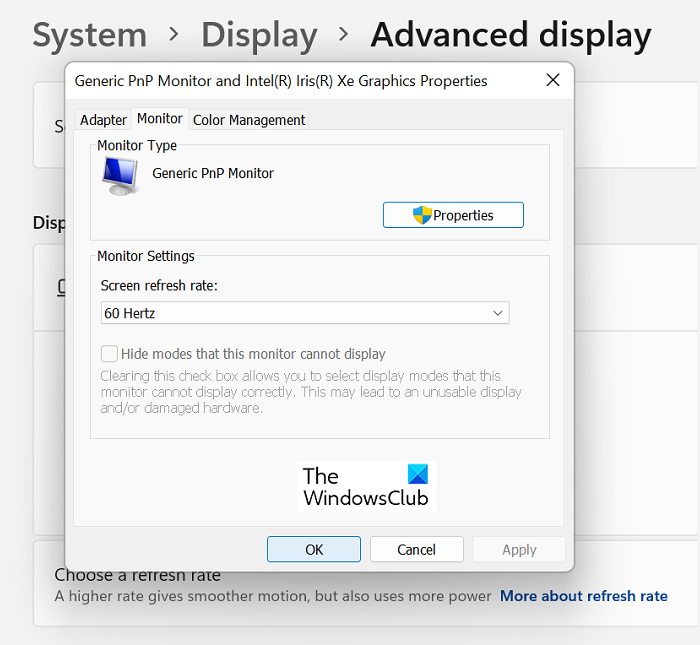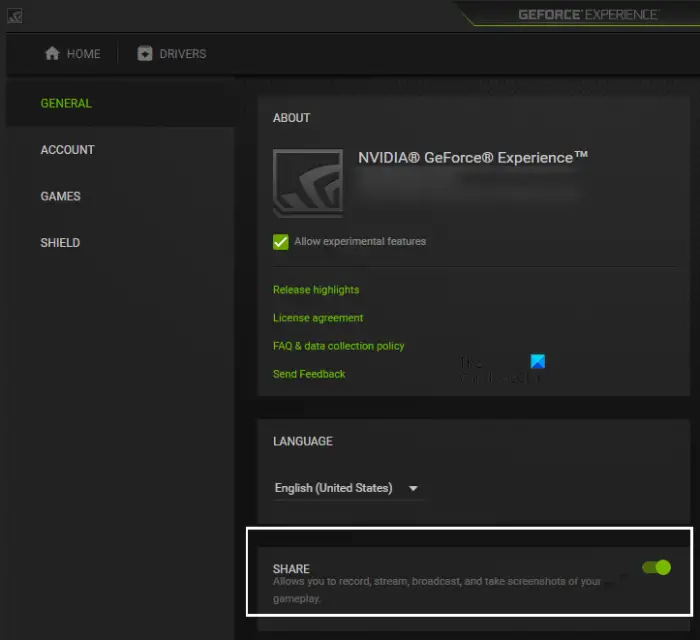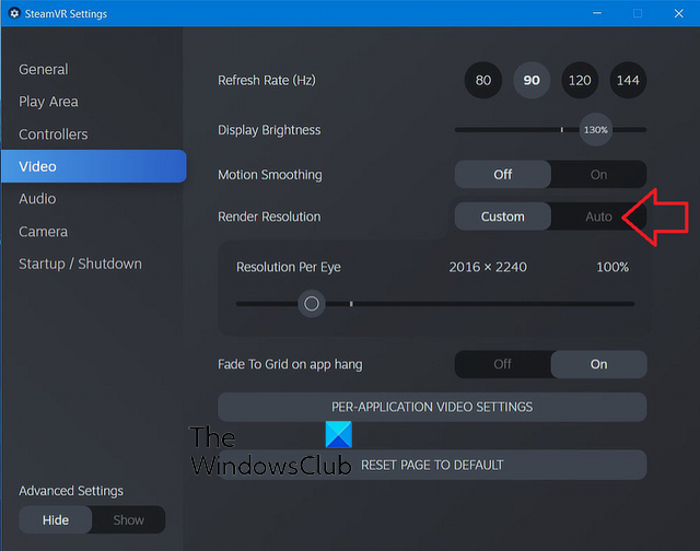Are Steam VR games lagging on your computer? Do you want to make your Steam VR games run better? Several gamers have reported experiencing performance issues while playing Steam VR games. If you are one of those users, this post is curated for you. Here, we will be showing you methods using which you can improve the performance of your Steam VR games and run them smoother and better.

How to make Steam VR Games run better?
Here are some methods you can use to make your Steam VR games run better on a Windows computer if they lag or stutter:
- Use some general tips and tricks.
- Update display and audio drivers to their latest versions.
- Lower your graphics card settings.
- Underclock your GPU.
- Adjust your refresh rate.
- Toggle off GeForce Experience Overlay.
- Switch on Motion Smoothing.
- Lower the render resolution.
- Change in-game graphics settings.
- Try a virtual desktop.
- Install the VR Performance Toolkit mod.
- Reinstall SteamVR if it still lags.
1] Use some general tips and tricks
You can start with some generic tips and tricks to improve the performance of your Steam VR games on Windows. Here are some tips to take care of:
If your SteamVR game is lagging, try rebooting your computer and your VR headset. In some instances, VR headsets can cause lagging issues with your games. So, restarting it can help you fix the problem.
Also, ensure your system meets the system requirements of the Steam VR games. Else, the games won’t perform smoothly. You can take SteamVR Performance Test on Steam and see if your PC can handle VR games.
In case you are using Oculus Air Link with Quest 2 to connect and play VR games on your PC, it might be causing the issue at hand. So, ensure that the Oculus Air Link Network requirements are fulfilled.
You also need to make sure that the USB cable using which you have connected your headset to your PC and the USB port are USB 3.0 or higher. SteamVR is likely to lag if you use the wrong cable or USB port.
Another thing you can do is close unnecessary resource-hungry programs from the background. If there are too many apps running in the background, your game is likely to lag due to the unavailability of the required amount of system resources. So, open Task Manager using Ctrl+Shift+Esc and then look for tasks consuming high system resources. After that, select the process and use the End task button to close it. Once done, try playing Steam VR games and check if the problem is fixed.
If you have taken care of the above tips, you can use another method to make SteamVR games run better.
Related: Fix SteamVR Error Codes 113, 200, 206, 207, 208, 301, 306, 308, 302
2] Update display and audio drivers to their latest versions
Before you move on to the next solution, make sure the problem is not at the end of your system. Outdated device drivers cause performance issues with games and other apps. So, update your device drivers to their latest versions especially graphics and audio drivers.
To do that, launch Windows Settings app by pressing Win+I and move to the Windows Update tab. After that, click on the Advanced options > Optional Updates option and then download & install all available device driver updates.
There are other methods to update your device drivers. Once done, reboot your computer and play Steam VR games to check if the problem is resolved.
3] Lower your graphics card settings
If you have set high graphics settings on a low-end or mid-range PC, you are likely to experience performance issues while playing Steam VR games. Hence, in that case, you can lower your graphics settings and then see if that helps run Steam VR games better or not.
For example, if you have an NVIDIA graphics card, you can open NVIDIA Control Panel and then click on the 3D Settings > Manage 3D Settings option. After that, go to the Global Settings tab and try setting graphics options to low or medium values. Or, you can keep adjusting the settings and see what works well for you. Similarly, you can lower other graphics card settings on your PC.
TIP: Best AMD Radeon Settings for gaming on PC.
4] Underclock your GPU
You can also try underclocking your GPU and see if it works for you. As reported by some users, underclocking has helped them run Steam VR games better. So, you can try doing the same and see if the problem is resolved.
5] Adjust your refresh rate

The next thing you can do is change your computer’s refresh rate. Multiple users have confirmed that adjusting their refresh rate has helped them run VR games better. For some users, lowering the refresh rate worked, while for a few users, setting a higher refresh rate was helpful. So, you can adjust the refresh rate accordingly and check what works for you. Here are the steps to do that:
- First, open your Settings app using Win+I and then go to the System > Display section.
- Now, scroll down to the Advanced display option under Related settings and tap on it.
- Next, click on the Choose a refresh rate drop-down option and select a different refresh rate than the current one.
- In case you want more options, click on the Display adapter properties for Display 1 option and then go to the Monitor tab.
- After that, choose a desired refresh rate and press the Apply > OK button to save changes.
You can now try playing your Steam VR games and see if the problem is resolved.
Besides your monitor’s refresh rate, you can also change the refresh rate of the Quest 2 headset and check whether it helps run VR games better or not. To do that, here are the steps to follow:
- First, open the Oculus software on your PC and then choose Devices.
- Now, select Quest 2 and Touch from the list of your devices.
- Next, locate the Graphics Preferences option and click on it.
- After that, select a desired Refresh Rate from the available ones.
- Finally, press the Save & Restart option and then check if your Steam VR games run smoothly or not.
Read: Oculus Software not installing on Windows 11.
6] Toggle off GeForce Experience Overlay

GeForce Experience Overlay can make your VR games laggy on your computer as reported by several users. Hence, in that case, you can disable the in-game overlay feature and see if it improves the performance of VR games or not. Here’s how you can do that:
- First, open the NVIDIA GeForce Experience app and make sure you are signed into your NVIDIA account.
- Now, press the Settings icon present in the top right corner.
- On the Settings page, go to the GENERAL tab from the left side.
- Next, simply disable the IN-GAME OVERLAY toggle.
Try running your games now and see if it has enhanced the overall performance or not.
Read: Oculus Quest not connecting to WiFi on PC; Keeps disconnecting
7] Switch on Motion Smoothing
Motion Smoothing in SteamVR is a nice feature that helps run the game smoothly when the frames drop. So, you can try enabling it in SteamVR and see if you see a significant improvement in your VR games. Here are the steps to enable Motion Smoothing in SteamVR:
- First, open SteamVR Settings and then go to the Video tab.
- Now, set the Motion Smoothing option to ON state.
- Once done, close the settings and try playing your games.
Hopefully, your SteamVR games will run better now. If not, you can use the next method to make your Steam VR games run better.
Read: Steam is not opening on Windows PC
8] Lower the render resolution

You can also try reducing the reader resolution in your SteamVR settings. It will basically make SteamVR render the game at a lower resolution. As a higher render resolution is more demanding graphically, it will cause lags and other performance issues in your games. So, lower the render resolution and see if that helps. Here are the steps to do that:
- Firstly, open the SteamVR Settings and simply move to the Video tab from the left-side pane.
- Now, choose the Custom option for Render Resolution and then adjust the Resolution Per Eye slider accordingly to lower it.
- Once done, play your VR game and see if there is any improvement in its performance.
See: SteamVR Error 1114, There is a problem with the Oculus runtime installation.
9] Change in-game graphics settings
To make a specific Steam VR game run better, you can adjust its in-game graphics settings. Running a game at lower configurations will automatically make it run better on a low-end PC. So, lower your in-game graphics settings and see if it enhances the game’s performance. You can disable the anti-aliasing feature, lower the render scale, reduce or disable certain graphics effects, etc.
Read: Fix SteamVR Headset Not Detected issue.
10] Try a virtual desktop
You can also use a virtual desktop to play VR games. Oculus Quest 2 users can download the Virtual Desktop app from the Oculus Store and see if it makes games run better or not.
11] Install the VR Performance Toolkit mod
There is this mod called VR Performance Toolkit developed especially for VR games. It helps in achieving more FPS and running the games better. You can download this mod from Github.com and then install it on your computer.
12] Reinstall SteamVR if it still lags
If the VR games still lag and there are other performance issues, the problem might lie in the SteamVR app. So, you can try uninstalling and then reinstalling the app to fix the issue. Before doing that, make sure to create a backup of your game data.
To uninstall SteamVR, open your Steam client and go to LIBRARY. From here, right-click on SteamVR and then choose the Uninstall option. After that, follow the prompted instructions and then complete the uninstallation process. Once done, reboot your computer and then reinstall SteamVR on your computer from Steam Store. Hopefully, the games will now perform well.
See: Fix SteamVR not working on Windows PC.
How do I make SteamVR run smoother Quest 2?
To make SteamVR games run smoother with Oculus Quest 2, you can optimize your Oculus Air Link connection. Some users have reported that reducing the refresh rate of their Quest 2 headset has helped them, while some users have confirmed that increasing the refresh rate improves their game’s performance. So, try lowering or increasing your Quest 2 headset refresh rate and see if your game run smoother or not.
Do VR games need a lot of RAM?
VR games do need more RAM than normal PC games. The RAM requirement varies from game to game. However, at least 8GB of memory is required by most VR games and VR headsets to run smoothly.
Now read: SteamVR keeps telling to update the Graphics driver.
Leave a Reply